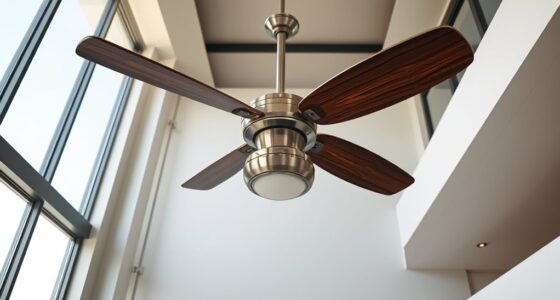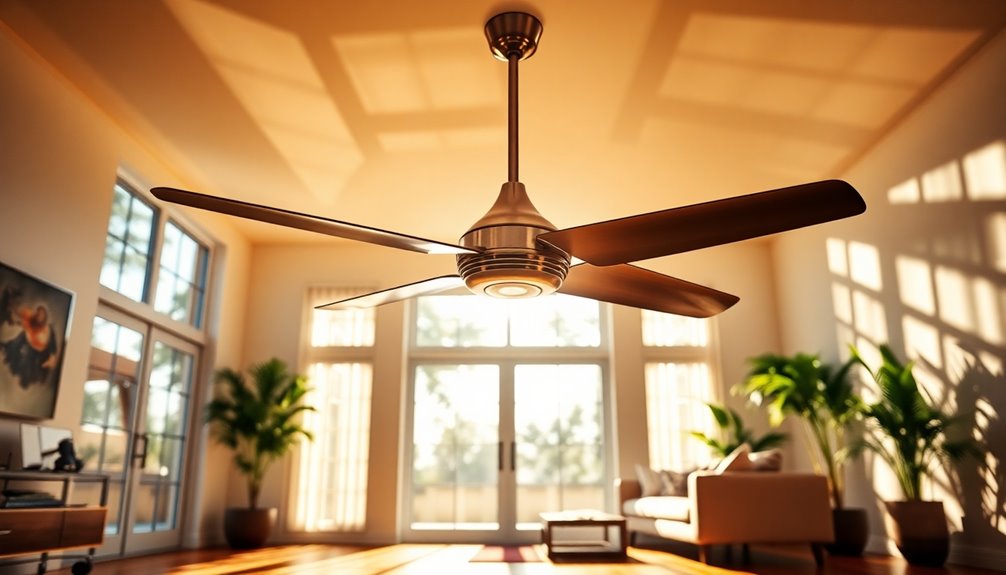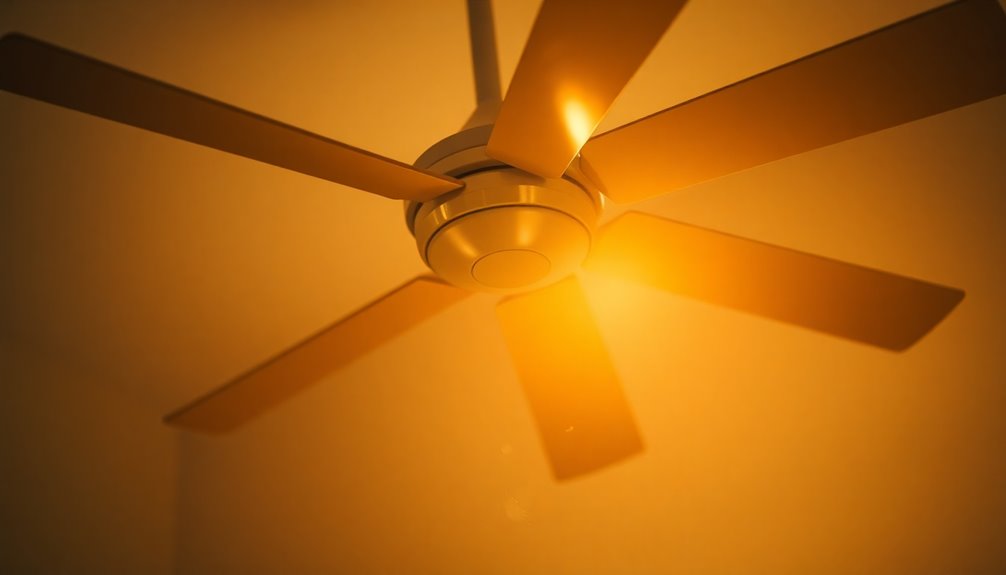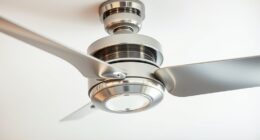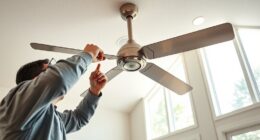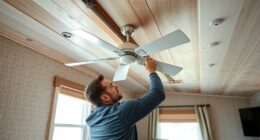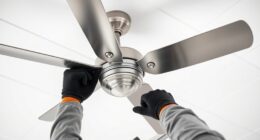When you're picking a light bulb for your ceiling fan, aim for around 800 lumens to guarantee good brightness. Most fans can handle bulbs with a maximum wattage of about 60 watts, so check your fan's specifications first. LED bulbs are a smart choice since they only need 8 to 12 watts to provide that same brightness while saving energy. Make certain the bulb base matches your fan's requirements, and consider getting dimmable options for added flexibility. Stick around to discover more tips on maximizing your ceiling fan's lighting potential!
Key Takeaways
- Check the ceiling fan's maximum wattage rating, typically around 60 watts, before selecting a bulb.
- Opt for LED bulbs that consume 8 to 12 watts for equivalent brightness of 800 lumens.
- Ensure the bulb's base type (E11, E12, E17, E26) matches the fan's light fixture for compatibility.
- Consider using dimmable bulbs for adjustable brightness that suits various activities and moods.
- Always consult the owner's manual for specific wattage recommendations and installation guidelines.
Choosing the Right Bulb

When it comes to choosing the right bulb for your ceiling fan, it's vital to take into account both brightness and energy efficiency. For ideal illumination, you should consider bulbs with a high lumen output, aiming for 800 lumens or more.
Standard 60-watt incandescent bulbs often fall short in providing the brightness you need for your space. Instead, go for energy-efficient options like LED bulbs, which consume lower wattage while delivering adequate brightness and lasting much longer.
Always check your ceiling fan light fixture's maximum wattage rating, usually around 60 watts for newer models. This helps you avoid overheating and potential damage.
Additionally, if you're looking for versatility, dimmable bulbs are a great choice for supplemental lighting, allowing you to adjust the brightness according to your mood or activity.
Lastly, make sure the bulb base type matches your ceiling fan's requirements. Whether it's a medium base (E26) or a candelabra base (E12), ensuring proper compatibility is essential for ideal performance.
Types of Ceiling Fan Bulbs

When choosing bulbs for your ceiling fan, you'll find a range of options, including incandescent and LED.
Incandescents offer a warm glow but consume more energy and have shorter lifespans, while LEDs provide the same brightness with significant energy savings.
Understanding these differences can help you make an informed decision that fits your needs.
Incandescent vs. LED Bulbs
Choosing the right type of bulb for your ceiling fan can greatly impact both your lighting experience and energy costs. When deciding between incandescent and LED bulbs, you'll notice a significant difference in wattage you can use.
Incandescent bulbs typically consume around 60 watts to produce approximately 800 lumens, which is suitable for general lighting but not energy-efficient. In contrast, LED lights can achieve the same brightness while using only 8 to 12 watts, leading to impressive energy savings.
Another advantage of LED bulbs is their versatility in color temperatures. While incandescent bulbs emit a warm light around 2700K, LED options are available in a range of color temperatures, allowing you to create the perfect ambiance for any room. This flexibility can enhance your overall lighting experience.
It's essential to check your ceiling fan's specifications, as many modern fans are designed for lower wattage LED bulbs, often rated between 6 to 15 watts.
Energy Efficiency Considerations
Selecting the right bulb for your ceiling fan not only affects the ambiance but also plays a significant role in energy efficiency. When choosing between options, LEDs stand out as the best choice. They use up to 80% less energy than incandescent bulbs while delivering the same brightness. This makes them ideal for ceiling fans, where you want both functionality and savings. Additionally, optimizing product descriptions can help consumers make informed decisions when selecting energy-efficient bulbs.
Compact fluorescent lamps (CFLs) are another option; they consume about 75% less energy than traditional incandescent bulbs and have a longer lifespan. However, they still fall short compared to LEDs regarding overall efficiency.
Incandescent bulbs may seem cheaper initially, but their shorter lifespan and higher energy consumption make them a less sustainable choice.
Opting for bulbs with lower wattage can also lead to significant savings. For instance, using a 6W LED to replace a 40W incandescent bulb drastically reduces your electricity bills over time.
Additionally, consider Energy Star-rated bulbs to guarantee compliance with energy efficiency standards, which translates to cost savings and a smaller carbon footprint. Moreover, selecting energy-efficient lighting can significantly enhance indoor air quality, which is crucial for maintaining a healthy living environment.
Bulb Base Compatibility

Understanding bulb base compatibility is important for guaranteeing your ceiling fan functions safely and effectively. Different types of ceiling fans use various bulb bases, including E11 (Mini Candelabra), E12 (Candelabra), E17 (Intermediate), and E26 (Medium). Identifying the correct bulb base is essential, as it directly impacts the wattage and type of ceiling fan bulb you can use.
Newer ceiling fans typically employ the medium screw base (E26), while older models may require different bases. To avoid compatibility issues, always check your fan's specifications.
It's also critical to verify the maximum wattage allowed for your fixture, which is usually indicated near the bulb socket. Exceeding this wattage can lead to overheating and potential fire hazards.
Additionally, verify that the bulb shape and size fit within the fan's light kits. Larger or incompatible bulbs may not function properly and could pose safety risks.
Understanding Wattage Limits

Knowing the correct bulb base is only part of the equation; wattage limits also play a significant role in ensuring your ceiling fan operates safely and efficiently. Each ceiling fan model typically has a maximum wattage rating indicated near the bulb socket.
It's essential not to exceed this limit, as doing so can lead to overheating and potential fire hazards. Most newer ceiling fan designs recommend a maximum of 60 watts for incandescent bulbs or their LED equivalents.
When you use bulbs that surpass this rated wattage, you risk damaging wiring insulation, which compromises safety. To avoid these risks, always consult the manufacturer's guidelines or the owner's manual for the specific wattage limits of your light fixtures.
Regularly checking the condition of your bulbs and ensuring you select the appropriate wattage not only helps maintain the integrity of your ceiling fan but also extends the lifespan of both the bulbs and the fan itself.
Brightness and Lumens

When it comes to ceiling fans, brightness is essential for creating a comfortable atmosphere, and that's where lumens come into play. Lumens measure how much light a bulb produces, making them a key factor in choosing ceiling fan lights.
A standard 60-watt incandescent bulb generates about 800 lumens, which is often the minimum for general lighting in most spaces. However, if you opt for LED bulbs, you can achieve the same brightness using only 8 to 10 watts.
Here are a few tips to take into account:
- For larger rooms, aim for higher lumen outputs (1,500+ lumens) for adequate illumination.
- Dimmable LED bulbs offer flexibility, allowing you to adjust brightness based on your needs and the time of day.
- Always check your ceiling fan's specifications for maximum wattage and lumen limits to guarantee safe and effective lighting.
Color Temperature Considerations

Choosing the right color temperature for your ceiling fan lights can transform the mood of your space. Color temperature, measured in Kelvin (K), plays an essential role in how a room feels and functions.
For a cozy, inviting atmosphere, opt for warm white bulbs in the 2700K-3000K range. These warmer tones are perfect for relaxed settings like living rooms and bedrooms.
On the other hand, if you need brighter, cooler tones for task-oriented spaces, consider bulbs in the 5000K-6500K range. This cooler light enhances visibility and alertness, making it ideal for kitchens or home offices.
When shopping for bulbs, pay attention to both the lumen output and the Kelvin measurements on the packaging. This information helps you choose the perfect lighting environments that suit your needs.
If you want more flexibility, specialty color-changing bulbs are available, allowing you to adjust the color temperature according to your mood or activity, though they may cost more.
Ultimately, the right color temperature can greatly impact how you experience your space, so take your time to make the best choice for your ceiling fan lights.
Dimmable Options for Flexibility

Dimmable bulbs give you the freedom to adjust brightness, making your ceiling fan lighting more versatile for different moods and tasks.
When you choose these options, it's essential to verify they're compatible with your fan's dimmer switch to avoid any issues.
Plus, opting for dimmable LED bulbs not only saves energy but also offers similar brightness to higher wattage incandescent bulbs.
Benefits of Dimmable Bulbs
The flexibility of dimmable bulbs offers you the power to adjust brightness levels and create the perfect ambiance for any occasion. Whether you're reading a book, entertaining guests, or winding down for the night, dimmable options let you customize the lighting to suit your needs.
Here are some key benefits of using dimmable bulbs in your ceiling fans:
- Energy Savings: Lower brightness settings consume less power, which helps reduce your energy bills.
- Versatile Atmosphere: You can easily switch between bright light for tasks and soft light for relaxation.
- Longer Lifespan: Dimming reduces heat output, leading to less wear and tear on your bulbs, so they last longer.
Integrating dimmable LED bulbs into your ceiling fan not only enhances comfort but also aligns with energy-efficient practices. Additionally, heat pumps can contribute to overall energy savings in your home, further optimizing your energy consumption.
Many of these bulbs are compatible with standard dimmer switches, making the change seamless.
Installation Considerations
When integrating dimmable bulbs into your ceiling fan, there are important installation considerations to keep in mind.
First, check the wattage of the dimmable bulbs you intend to use. Make certain it doesn't exceed the maximum rating specified by the ceiling fan manufacturer. This step is essential to maintain safety and prevent overheating.
Next, consider the compatibility of the bulbs with your fan's dimmer switch. Not all dimmable bulbs work seamlessly with every dimmer; older dimmer switches may not be compatible with modern LED dimmable options, leading to flickering or reduced performance.
Choosing energy-efficient LED bulbs that offer dimmable features can enhance your lighting experience while reducing energy consumption.
These bulbs provide adjustable brightness levels, making them versatile for different lighting scenarios. However, verify that the dimmer switch you have can handle these energy-efficient bulbs effectively.
Choosing Compatible Options
Finding the right dimmable LED bulbs for your ceiling fan can enhance the ambiance of your space while maximizing energy efficiency.
Dimmable LED bulbs provide the flexibility to adjust brightness, helping you create the perfect mood. However, it's essential to verify compatibility to avoid issues like flickering or buzzing.
Here are three key considerations:
- Dimming Technology: Check that the dimmable bulbs work with your ceiling fan's dimmer switch.
- Wattage: Dimmable LED bulbs typically range from 5 to 15 watts, offering significant energy savings compared to traditional incandescent bulbs, which range from 40 to 100 watts.
- Owner's Manual: Always refer to your ceiling fan's owner manual for maximum wattage recommendations to guarantee safety and performance.
Long-lasting Energy-Efficient Choices

Choosing long-lasting energy-efficient light bulbs for your ceiling fan can considerably reduce your energy consumption and maintenance efforts.
LED bulbs stand out as the best option, typically lasting between 15,000 to 50,000 hours while consuming up to 80% less energy than traditional incandescent bulbs. By opting for a 6W LED bulb, you can achieve the same brightness as a 40W incandescent bulb, allowing you to save energy without compromising on illumination.
While CFL bulbs offer a longer lifespan than incandescent options, lasting about 10,000 hours, they still can't compete with the longevity of LEDs.
When selecting wattage for your ceiling fan, consider that modern designs often recommend lower wattage options, like 6W or 9W LEDs. This guarantees both safety and efficiency, especially in newer models.
To further enhance your energy savings, look for Energy Star-rated bulbs. These products meet strict energy efficiency guidelines, leading to lower electricity bills and a reduced environmental impact.
Safety and Installation Tips

To guarantee a safe and effective lighting experience in your ceiling fan, always pay attention to the maximum wattage rating indicated near the bulb socket. Exceeding this limit can lead to overheating and fire hazards.
Here are some essential safety and installation tips to keep in mind:
- Turn off the power: Before replacing any bulbs, always switch off the power at the circuit breaker to prevent electrical shocks.
- Choose compatible bulbs: Use bulbs specifically designed for your ceiling fan to confirm a proper fit and minimize heat generation.
- Regular inspections: Frequently check the wiring and connections in your ceiling fan for any signs of wear or damage.
If you're unsure about the wattage limits or installation procedures, don't hesitate to consult the manufacturer's guidelines or contact a licensed electrician.
Following these safety measures will help you maintain a well-functioning ceiling fan while confirming your home remains safe.
Frequently Asked Questions
Can You Put a 60 Watt Bulb in a 40 Watt Ceiling Fan?
You shouldn't put a 60-watt bulb in a ceiling fan rated for 40 watts.
Doing so can cause overheating, which might damage the fan and create a fire hazard. Always check the wattage limits listed near the bulb socket to guarantee safety.
It's best to use a bulb that matches or is below the specified wattage. Opting for a 40-watt bulb or an equivalent LED will keep things safe and energy-efficient.
How Do I Know What Light Bulb I Need for My Ceiling Fan?
To know what light bulb you need for your ceiling fan, start by checking the owner's manual for the maximum wattage allowed.
Next, verify the bulb's base type matches your fixture, whether it's E12 or E26.
Consider the lumen output for brightness; 800 lumens or more is ideal for main lighting.
Finally, pay attention to the color temperature for the right ambiance, choosing warmer tones for a cozy feel or cooler tones for clarity.
What Wattage Bulb Do I Need for Ceiling Lights?
When choosing the wattage for your ceiling lights, start by checking the fixture's maximum wattage, usually labeled near the bulb socket.
Most fixtures allow up to 60 watts, but older models may permit more.
It's smart to opt for LED bulbs, as they offer the same brightness while using less energy.
Don't forget to consult the owner's manual for specific recommendations to guarantee safety and peak performance for your lighting needs.
Can I Use a 100 Watt LED Bulb in a Ceiling Fan?
You can't use a 100 watt LED bulb in your ceiling fan if it exceeds the fan's maximum wattage rating.
Even though LED bulbs are more efficient and cooler, they can still generate enough heat to cause issues in enclosed fixtures.
It's essential to check your fan's manual for its wattage limit.
For adequate brightness, consider using multiple lower wattage bulbs that stay within the recommended range for safety and best performance.
Conclusion
In choosing the right watt light bulb for your ceiling fan, it's all about balance. You want bright, efficient illumination without overwhelming the space. A lower wattage can save energy, while a higher wattage can enhance brightness. Just remember, not all bulbs fit every fixture, so compatibility matters. Embrace energy-efficient options for longevity, yet don't sacrifice ambiance. Ultimately, the right bulb transforms your fan from a mere fixture into a vibrant part of your home's atmosphere.


